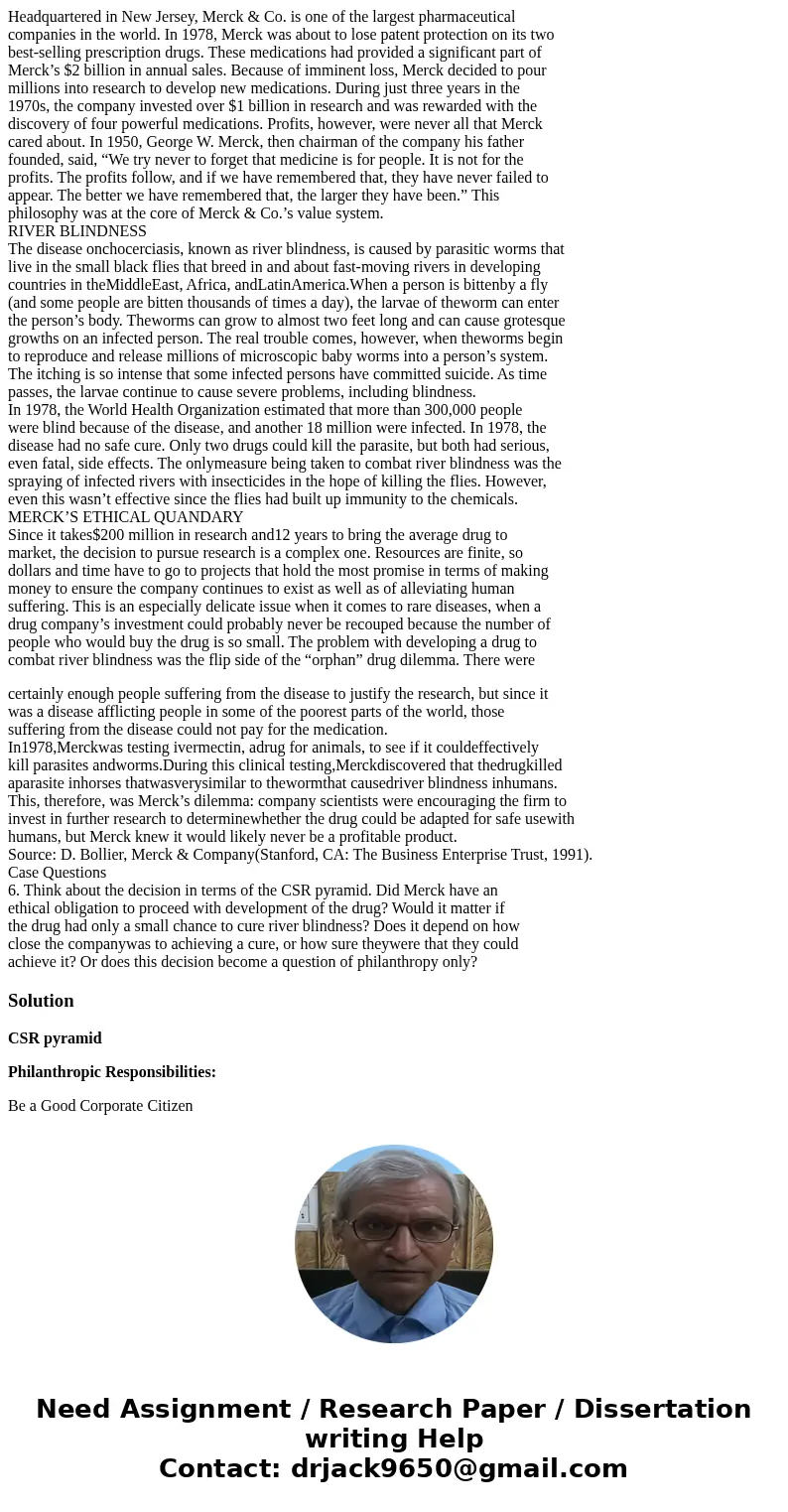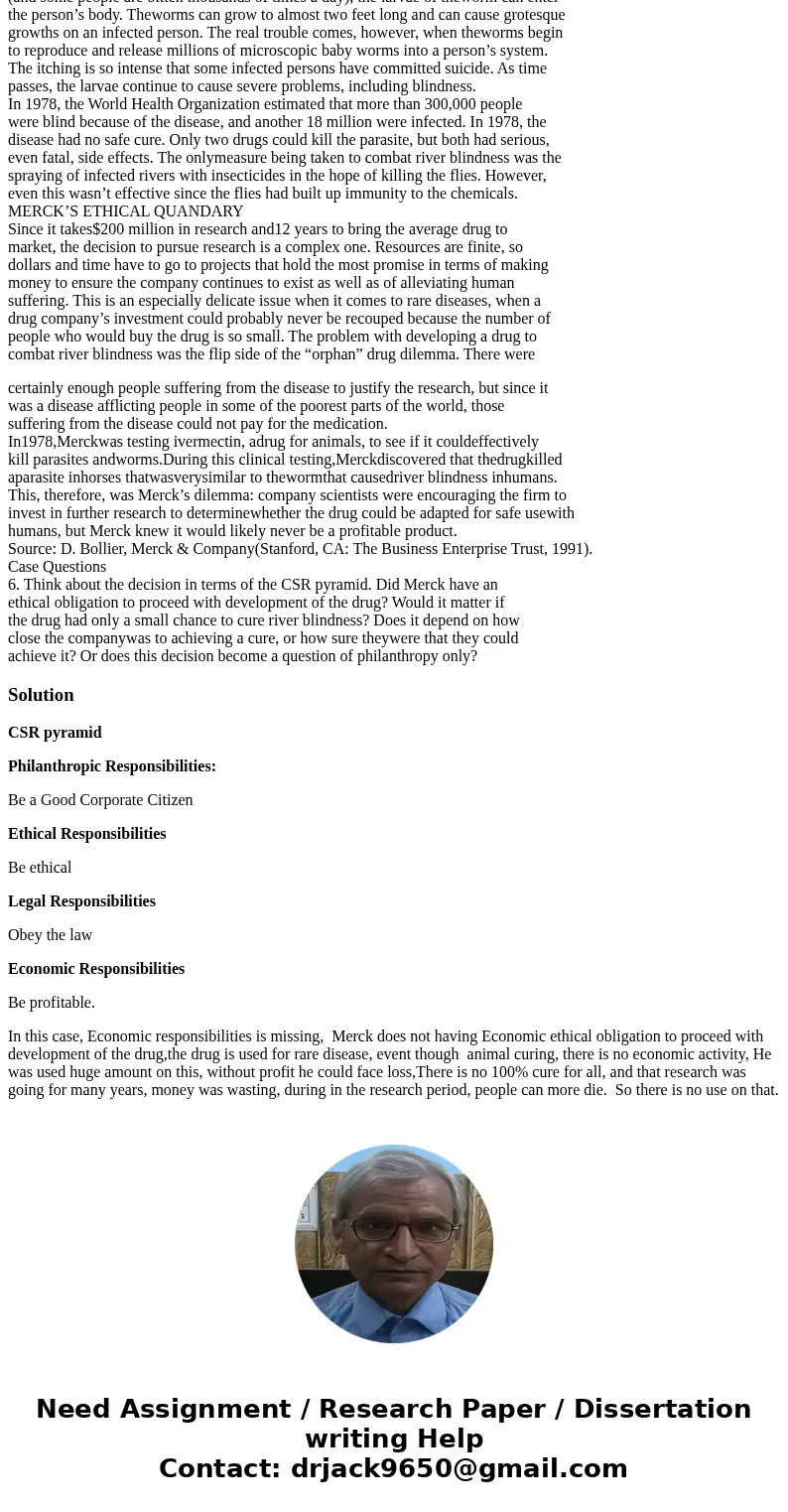Headquartered in New Jersey Merck Co is one of the largest
Headquartered in New Jersey, Merck & Co. is one of the largest pharmaceutical
companies in the world. In 1978, Merck was about to lose patent protection on its two
best-selling prescription drugs. These medications had provided a significant part of
Merck’s $2 billion in annual sales. Because of imminent loss, Merck decided to pour
millions into research to develop new medications. During just three years in the
1970s, the company invested over $1 billion in research and was rewarded with the
discovery of four powerful medications. Profits, however, were never all that Merck
cared about. In 1950, George W. Merck, then chairman of the company his father
founded, said, “We try never to forget that medicine is for people. It is not for the
profits. The profits follow, and if we have remembered that, they have never failed to
appear. The better we have remembered that, the larger they have been.” This
philosophy was at the core of Merck & Co.’s value system.
RIVER BLINDNESS
The disease onchocerciasis, known as river blindness, is caused by parasitic worms that
live in the small black flies that breed in and about fast-moving rivers in developing
countries in theMiddleEast, Africa, andLatinAmerica.When a person is bittenby a fly
(and some people are bitten thousands of times a day), the larvae of theworm can enter
the person’s body. Theworms can grow to almost two feet long and can cause grotesque
growths on an infected person. The real trouble comes, however, when theworms begin
to reproduce and release millions of microscopic baby worms into a person’s system.
The itching is so intense that some infected persons have committed suicide. As time
passes, the larvae continue to cause severe problems, including blindness.
In 1978, the World Health Organization estimated that more than 300,000 people
were blind because of the disease, and another 18 million were infected. In 1978, the
disease had no safe cure. Only two drugs could kill the parasite, but both had serious,
even fatal, side effects. The onlymeasure being taken to combat river blindness was the
spraying of infected rivers with insecticides in the hope of killing the flies. However,
even this wasn’t effective since the flies had built up immunity to the chemicals.
MERCK’S ETHICAL QUANDARY
Since it takes$200 million in research and12 years to bring the average drug to
market, the decision to pursue research is a complex one. Resources are finite, so
dollars and time have to go to projects that hold the most promise in terms of making
money to ensure the company continues to exist as well as of alleviating human
suffering. This is an especially delicate issue when it comes to rare diseases, when a
drug company’s investment could probably never be recouped because the number of
people who would buy the drug is so small. The problem with developing a drug to
combat river blindness was the flip side of the “orphan” drug dilemma. There were
certainly enough people suffering from the disease to justify the research, but since it
was a disease afflicting people in some of the poorest parts of the world, those
suffering from the disease could not pay for the medication.
In1978,Merckwas testing ivermectin, adrug for animals, to see if it couldeffectively
kill parasites andworms.During this clinical testing,Merckdiscovered that thedrugkilled
aparasite inhorses thatwasverysimilar to thewormthat causedriver blindness inhumans.
This, therefore, was Merck’s dilemma: company scientists were encouraging the firm to
invest in further research to determinewhether the drug could be adapted for safe usewith
humans, but Merck knew it would likely never be a profitable product.
Source: D. Bollier, Merck & Company(Stanford, CA: The Business Enterprise Trust, 1991).
Case Questions
6. Think about the decision in terms of the CSR pyramid. Did Merck have an
ethical obligation to proceed with development of the drug? Would it matter if
the drug had only a small chance to cure river blindness? Does it depend on how
close the companywas to achieving a cure, or how sure theywere that they could
achieve it? Or does this decision become a question of philanthropy only?
Solution
CSR pyramid
Philanthropic Responsibilities:
Be a Good Corporate Citizen
Ethical Responsibilities
Be ethical
Legal Responsibilities
Obey the law
Economic Responsibilities
Be profitable.
In this case, Economic responsibilities is missing, Merck does not having Economic ethical obligation to proceed with development of the drug,the drug is used for rare disease, event though animal curing, there is no economic activity, He was used huge amount on this, without profit he could face loss,There is no 100% cure for all, and that research was going for many years, money was wasting, during in the research period, people can more die. So there is no use on that.


 Homework Sourse
Homework Sourse